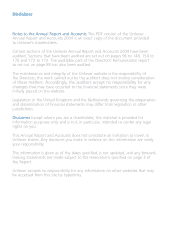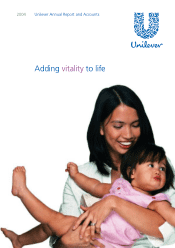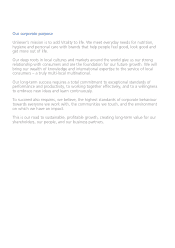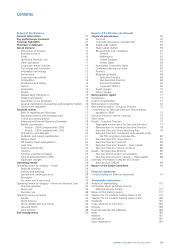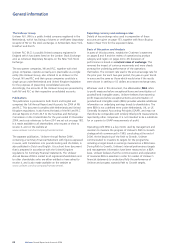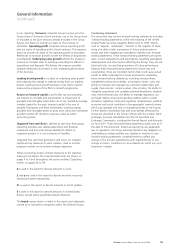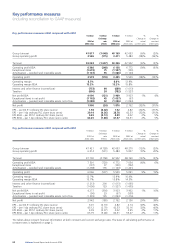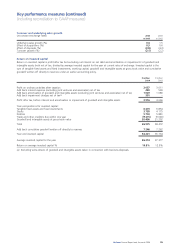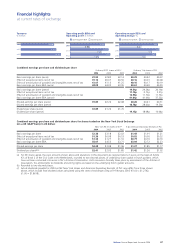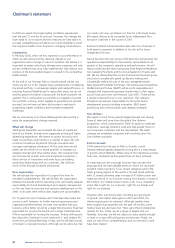Unilever 2004 Annual Report Download - page 5
Download and view the complete annual report
Please find page 5 of the 2004 Unilever annual report below. You can navigate through the pages in the report by either clicking on the pages listed below, or by using the keyword search tool below to find specific information within the annual report.02 Unilever Annual Report and Accounts 2004
General information
The Unilever Group
Unilever N.V. (NV) is a public limited company registered in the
Netherlands, which has listings of shares or certificates (depositary
receipts) of NV on the stock exchanges in Amsterdam, New York,
Frankfurt and Zürich.
Unilever PLC (PLC) is a public limited company registered in
England which has shares listed on the London Stock Exchange
and, as American Depositary Receipts, on the New York Stock
Exchange.
The two parent companies, NV and PLC, together with their
group companies, operate as nearly as is practicable as a single
entity (the Unilever Group, also referred to as Unilever or the
Group). NV and PLC and their group companies constitute a
single group under Netherlands and United Kingdom legislation
for the purposes of presenting consolidated accounts.
Accordingly, the accounts of the Unilever Group are presented by
both NV and PLC as their respective consolidated accounts.
Publications
This publication is produced in both Dutch and English and
comprises the full Annual Report and Accounts for 2004 of NV
and PLC. This document complies with Netherlands and United
Kingdom regulations. It also forms the basis of the NV and PLC
Annual Reports on Form 20-F to the Securities and Exchange
Commission in the United States for the year ended 31 December
2004, and cross references to Form 20-F are set out on page 182.
It is made available to all shareholders who request or elect to
receive it, and on the website at
www.unilever.com/ourcompany/investorcentre/.
The separate publication, ‘Unilever Annual Review 2004’,
containing a Summary Financial Statement with figures expressed
in euros, with translations into pounds sterling and US dollars, is
also published in Dutch and English. It is a short form document
that is prepared in accordance with the United Kingdom
regulations for Summary Financial Statements. The Unilever
Annual Review 2004 is mailed to all registered shareholders and
to other shareholders who are either entitled or have asked to
receive it, and is also made available on the website at
www.unilever.com/ourcompany/investorcentre/.
Reporting currency and exchange rates
Details of key exchange rates used in preparation of these
accounts are given on page 153, together with Noon Buying
Rates in New York for the equivalent dates.
Basis of Discussion and Analysis
In parts of this document, notably the Chairmen’s statement
on pages 8 and 9 and the review of operations by product
category and region on pages 24 to 49, discussion of
performance is based on constant rates of exchange. This
removes the impact of currency movements and more clearly
portrays the underlying performance of the operations
themselves. The constant rate used is the annual average rate for
the prior year. For each two-year period, the year-on-year trends
in euros are the same as those which would arise if the results
were shown in sterling or US dollars at constant exchange rates.
Wherever used in this document, the abbreviation BEIA refers
to profit measures before exceptional items and amortisation of
goodwill and intangible assets. Unilever believes that reporting
profit measures before exceptional items and amortisation of
goodwill and intangible assets (BEIA) provides valuable additional
information on underlying earnings trends to shareholders. The
term BEIA is not a defined term under Netherlands, UK, or US
Generally Accepted Accounting Principles (GAAP), and may not
therefore be comparable with similarly titled profit measurements
reported by other companies. It is not intended to be a substitute
for or superior to GAAP measurements of profit.
Operating profit BEIA is a key metric used by management and
investors to measure the progress of Unilever’s Path to Growth
strategy which commenced in 1999, concluding at the end of
2004. At the beginning of the Path to Growth, Unilever
communicated to investors its targets for the programme,
including a target based on earnings measured on a BEIA basis.
During Path to Growth, Unilever’s internal performance targets
and management information have been measured on a BEIA
basis. Unilever believes that the communication and explanation
of measures BEIA is essential in order for readers of Unilever’s
financial statements to understand fully the performance of
Unilever and progress towards Path to Growth targets.

